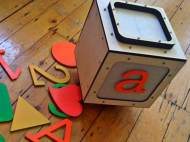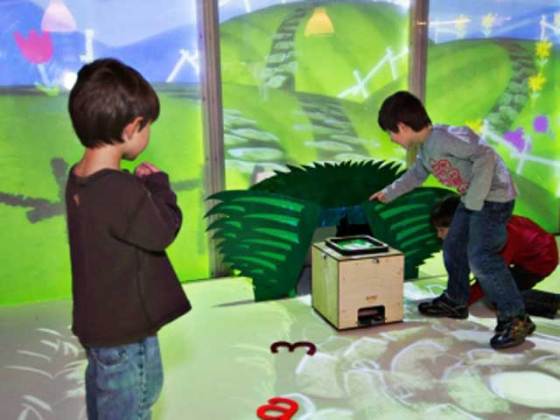MIT Alphabet prototype robot connects the real world with virtual
 In order to counter the multimedia brought by TV shows and video games which leave kids stationary, the researchers at the MIT Media Laboratory are developing a system called Playtime Computing. Aside the projectors, the prototype of the Playtime Computing system consists of a cube-shaped, remote-controlled robot, called the Alphabot, with infrared emitters at its corners that are tracked by cameras mounted on the ceiling.
In order to counter the multimedia brought by TV shows and video games which leave kids stationary, the researchers at the MIT Media Laboratory are developing a system called Playtime Computing. Aside the projectors, the prototype of the Playtime Computing system consists of a cube-shaped, remote-controlled robot, called the Alphabot, with infrared emitters at its corners that are tracked by cameras mounted on the ceiling.
The system is designed to make the distinctions between its technical components disappear. Three door high panels offer a window on a virtual world that, courtesy of the overhead projectors, appears to spill into the space in front of it.
“One of the things we’re really excited about is having two of these spaces, one here and maybe one in Japan, and when the robot goes into the virtual world here, it comes out of the virtual world in Japan. So that kind of fits in with that one-reality concept, that there’s one robot, and whether it’s physical or virtual is based on the state of the robot in the Playtime Computing system”, said Adam Setapen, a graduate student in Professor Cynthia Breazeal’s Personal Robotics Group, who helped in the system design.
According to David Robert, another graduate student who worked on the project, the purpose of the system is to give children between the ages of 4 and 6 an opportunity for what developmental psychologists call “imaginative play” – early experimentation with symbolic reasoning and social roles that’s crucial to cognitive development. And, Setapen adds, the researchers also want to get kids out of their chairs.
Setapen, Robert and their fellow grad student Natalie Freed built a set of wooden symbols that can be attached to the face of the Alphabot. Among the symbols are letters of the Roman alphabet, Japanese characters, a heart and a pair of musical notes. When children attach the notes to the Alphabot, music begins to play from the system’s speakers, illustrating the principle that symbolic reasoning can cut across sensory modalities. If a child changes the symbol on the Alphabot, the Alphabot’s face changes its color to match that of the symbol. And if the robot then rolls onto the screen, the virtual Alphabot displays the new symbol as well. Each symbol contains an RFID tag, and inside the Alphabot is a tag reader which enables the interaction.
Another, vital element of the system is what the researchers call the Creation Station, a tabletop computer on which children can arrange existing objects or draw their own pictures. Whatever’s on the tabletop can be displayed by the projectors, giving children direct control over their environment.
To make the Playtime Computing system even more interactive, the researchers have outfitted baseball caps with infrared light emitters, so that the same system that tracks the Alphabot could also track playing children. However, the researchers are planning to begin experimenting with the Microsoft Kinect, because it could offer an affordable means of tracking motion in the Playtime Computing environment, without requiring kids to wear hats.
The prototype of the Alphabot, the researchers say, uses a few hundred dollars’ worth of off-the-shelf parts, and if the robot were mass-produced, affordable versions of the Playtime Computing system could be designed for home use, while more elaborate versions, with multiple, multifunctional robots, could be used in the classroom or at museums.










Tho it shows some potential, i can’t see my kid occupied with this sort of entertainment for a longer period of time. Compared to Siftables you wrote about a while ago, this is far more complex to develop into something as practicable and affordable.